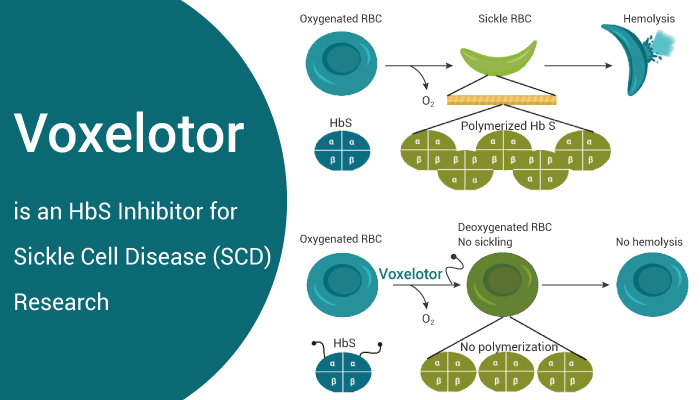Sickle cell hemoglobin (HbS) is caused by a mutation that replaces a glutamic acid at residue 6 in beta-globin with a valine. This amino acid substitution results in the formation of linear polymers of deoxy HbS. Removal of O from HbS in tissue exposes complementary sites that are also on the surface. Then, Valine residues on the surface of HbS bind to complementary sites, linking the two tetramers together. As more tetramers join, linear polymers form, transforming normally flexible red blood cells into stiff sickle cells. In addition to being irregular in shape, sickled RBCs also tend to stick to the walls of blood vessels. As a result, sickled RBCs can clog blood vessels, preventing normal blood flow and reducing oxygen delivery to organs and tissues. Sickle cells are also highly prone to hemolysis, leading to chronic anemia.

Voxelotor is an HbS inhibitor for sickle cell disease (SCD) research.
Voxelotor, also known as GBT 440, is a potent inhibitor of HbS polymerization. It has the potential for sickle cell disease (SCD) treatment. Firstly, Voxelotor binds N-terminal hemoglobin (Hb) chains and increases the affinity of HbS for oxygen. Besides, it delays HbS polymerization in vitro and prevents RBC sickling. Secondly, in a mouse model of SCD, Voxelotor (100-150 mg/kg; administered twice daily) reduces ex vivo sickle cells and prolongs erythrocyte ( RBC) half-life by oral gavage for 9-12 days. In addition, it shows T1/2s of 11.7, 19.1±1.5, 66.0±11, 28.8±4.0 hours for mouse (70 mg/kg; i.v.), rat (1.6 mg/kg; i.v.), dog (1 mg/kg; i.v.), and monkey (1 mg/kg; i.v.), respectively. Also, it shows Cmaxs of 81.9, 71.2±6.0, 5.56±1.6, and 25.2±5.5 μg/mL for mouse (30 mg/kg; p.o.), rat (7.2 mg/kg; p.o.), dog (2.5 mg/kg; p.o.), and monkey (4.25 mg/kg; p.o.), respectively.
In conclusion, Voxelotor (GBT 440) is a potent inhibitor of sickle HbS polymerization for the study of sickle cell anemia.
References:
[1] Donna Oksenber, et al. Br J Haematol. 2016 Oct;175(1):141-53.
[2] A Ashley-Koch, et al. Am J Epidemiol. 2000 May 1;151(9):839-45.